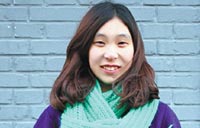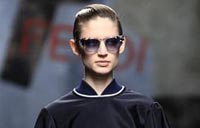Cosmetics chemist finds the art in science
 |
|
Cosmetics chemist Loretta Miraglia introduces her latest creation, The Treatment Lotion, of the luxury skincare brand La Mer at a press conference in Beijing. Photo provided to China Daily |
 |
| Bright & Chic |
 |
| Fendi Autumn/Winter 2014 collection |
Loretta Miraglia is not the typical geek that the phrase "female scientist" might bring to mind. She does not wear a white lab coat or talk in jargon.
The glamorous blonde woman wears an exaggerated white jacket with giant buttons, and a short navy blue skirt, when meeting with media in Beijing.
She is corporate senior vice-president of global brand product development and innovation for the skin-care label La Mer. Her job? Not that fancy. Miraglia deals with different kinds of chemical materials, beakers, test tubes and alcohol burners.
This time in Beijing, she was introducing her latest creation, The Treatment Lotion. The hydrator drives moisture and energy into the skin, which helps to improve the texture and appearance of skin tone.
Miraglia's talent in cosmetics was discovered many years ago. After Max Huber, founder of La Mer and also a physicist, died, his daughter tried to keep the brand alive. She approached Miraglia, then a physicist, and asked her to help.
When Miraglia started working in a skincare company, she didn't know much about skin. However, she found a way to connect the two jobs.
"It's the way you look at things. Physicists are different. The question 'why?' is heard a lot. You always hear people asking why the sky is blue - typical of a physicist. (Here in my job)why is it important? Why am I going to use that material? That is my daily job in a beauty company,"Miraglia says.
It is a daunting task, however, to be the top scientist in a beauty company. Miraglia has to become a jill-of-all-trades. She has to know about technology, entertainment, design and material science.
For example, after developing a new product, she has to think about its package design: Should it be stored in a round bottle or a thin one? Miraglia also has to know about celebrities: What kind of female stars can speak for this product? That is why she works with think tanks in Milan, Amsterdam, Paris and New York.
"Half of the time, we will talk for hours about segmental parts of different industries. What has that to do with cosmetics? But it does. Eventually, it all means something to each other," she says.
On the other hand, a scientist does not have to satisfy consumers, but working as a scientist in a cosmetic company means you will have to create continual surprises for them. That is the most challenging part of the job, Miraglia says.
"If we don't find that 'hit note', we don't launch it. It's one of the reasons that it takes so long to create a product, like four or five years. It is a long view," she says.






















